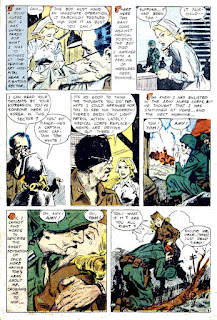A few months ago I showed a story by artist Everett Raymond Kintsler. It was a romance comic, like today’s posting. Far back in my past (50 years ago...yikes) I saw a couple of Kintsler comic book stories and thought his work didn't belong in comic books. My prejudices at the time were that comic book stories should look more like comic books than illustration. My complaint was that Kinstler’s art style looked more like those illustrations in slick magazines. Comic books just seemed like a whole other place, and purpose, than the illustrative work Kinstler did. I have changed my mind over those years, and now see his work as being solid story telling, but drawn with lines that were in vogue during the time of James Montgomery Flagg. Kinstler said more than once that Flagg was his inspiration, so an acolyte of Flagg ended up drawing comic books. Kinstler never disavowed his years in the comics, and I am sure they helped him learn how to draw just about everything needed in comics, which was also useful in his later art career.
Kinstler left comics and went into fine art. I admire that. He went on to do some great work. He died in 2019, age 92.
From Realistic Romance #8 (1952):
Translate
Monday, November 22, 2021
Number 2576: The comic artist who became the fine artist
Subscribe to:
Post Comments (Atom)









2 comments:
I would hate to have a girl-friend in or near a combat zone, and her being there to be near me would make things seem far worse. (Though still unhappy, I would respect most other plausible commitments that would get her to place herself in harm's way.)
I quite understand how you once felt about Kinstler's style. It takes more work to understand the imagery than does more typical comic-book illustration.
Yet that style helps this story, giving a more serious depiction. A different style, even if of high technical quality, could make the story seem just banal.
However, I think that the effective contradiction of having Amy concerned in one panel that Tom might die only to reveal anticlimactically in the next that his injuries weren't serious is disastrous to the story-telling. (Ordinarily, someone would just have informed her, both as an act of kindness and to ensure her performance.) And, in any case, at least one more page was needed to make the story really work.
Gorgeous work. He is probably like Curt Swan, who initially intended to be an illustrator. I am sure that was Kinstler’s intent, too.
Post a Comment